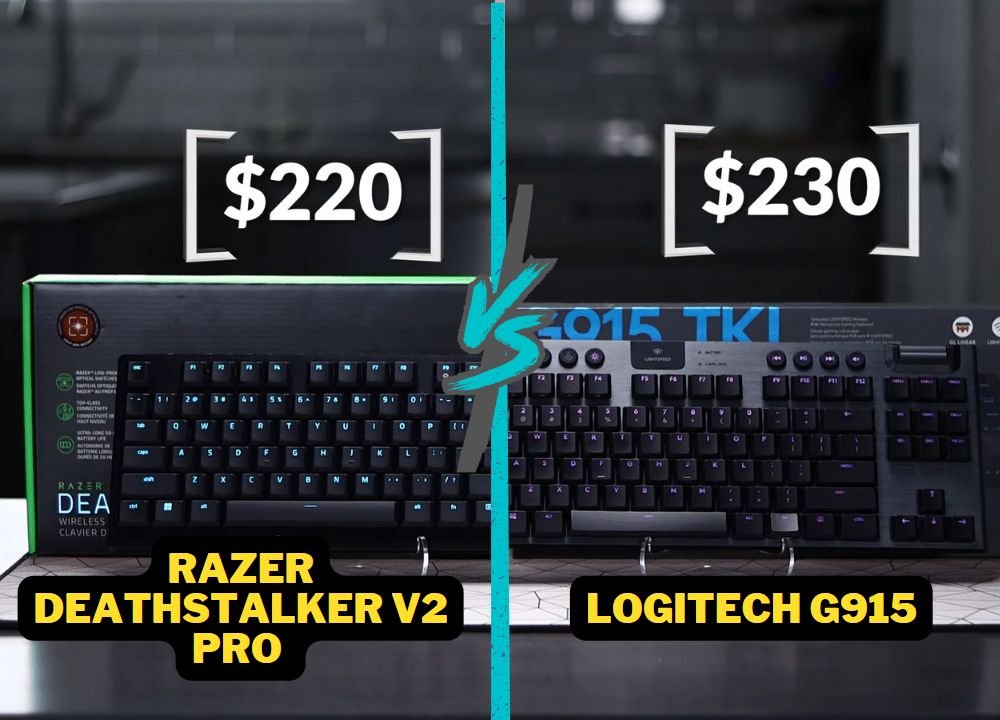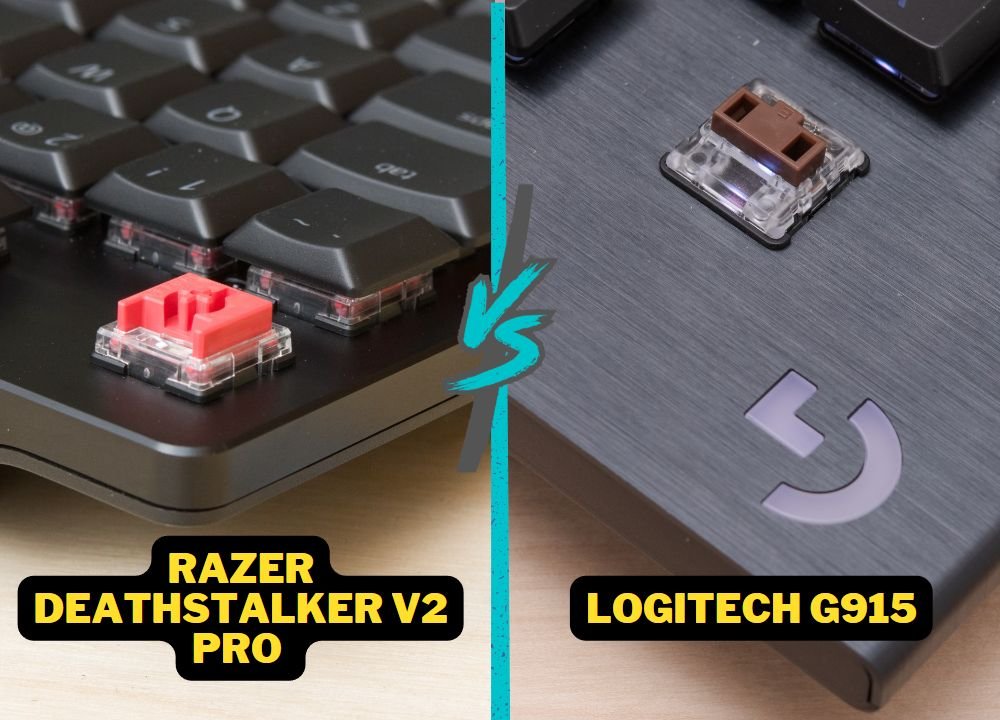The Razer DeathStalker V2 Pro TKL and Logitech G915 TKL both fall into a more niche segment of keyboards that are low-profile but definitely offer a more unique experience. Today, though, we will be putting them head-to-head. so you can decide which one is best for your requirements.
The DeathStalker V2 Pro TKL costs $220, ten dollars less than the Logitech G915, which costs $230.
Check price on Amazon: DeathStalker V2 Pro TKL | Logitech G915 TKL

Design
- Both keyboards have a TKL layout, but the Razer DeathStalker V2 Pro TKL has a more compact design.
- Both keyboards feature thin and sturdy construction with an aluminum alloy top plate and plastic bottom housing.
- The Logitech G915 TKL has a slightly larger footprint due to additional controls above the arrow keys.
- Both keyboards have rubber feet for stability and two levels of incline adjustment for ergonomic positioning.
Though both keyboards have a TKL layout, the G915 has a larger footprint due to the extra rubber buttons. You’ll notice some extra controls above your function key row, the functionality of which is useful, but it just makes for a slightly larger keyboard. Overall.

Both keyboards are very comparable in terms of thickness, but the G915 does slightly edge out the DeathStalker, coming in just a hair thinner, which is very minor and not a big deal unless you want something as thin as possible. Top plates are aluminum alloy, and bottom housings are plastic, despite their thin frames. Although the G915 feels a little more sturdy, that could be because they also reinforced the bottom plastic housing with steel.
Even when applying moderate pressure to both keyboards, the frames flexed only slightly.
The DeathStalker and G915 have rubber feet to stay stuck on your desk. Both keyboards have flip-out legs to adjust the angle, which is good for your wrists and shoulders. If you like your keys slightly angled up,
Connectivity
- Both keyboards can be used wirelessly with the included dongle, offering a 2.4 GHz wireless connection for gaming.
- They also have Bluetooth connectivity options, suitable for travel or daily use.
- Charging is done through a USB-C port on the Razer DeathStalker V2 Pro TKL and a micro USB port on the Logitech G915 TKL.
With the included dongle, both keyboards can use the fastest wireless connection, 2.4 GHz. You can connect to Bluetooth with the Logitech G915 TKL button or the Razer DeathStalker V2 Pro TKL switch.
To enter that connectivity mode, which may be more useful for you, especially if you’re using this as a travel or daily use board, you’ll need to use the included dongle, but for gaming, you’ll need to use the included dongle.
Both keyboards need to be plugged in to charge. DeathStalker has a USB-C port, whereas G915 has a micro USB port on the back.
Each keyboard has built-in idle timers that turn on when the RGB dims or turns off completely. These timers can be changed in the keyboard’s software. But there is one important thing to remember: The Deathstalker does turn off completely. This is a big deal for a lot of people. Compared to the G915, it takes a few seconds to wake up.
Switches
- The Razer DeathStalker V2 Pro TKL uses low-profile optical switches, offering faster actuation and longer durability.
- The Logitech G915 TKL offers a choice of low-profile mechanical switches: clicky,
You can find your preferred low-profile switch beneath these low-profile keycaps. On a Deathstalker, you can choose either a clicky or a linear switch. In the G915, you can choose between a GL clicky switch, a GL linear switch, or a GL tactile switch.

Razer uses its own low-profile optical switches instead of Logitech’s low-profile mechanical switches. Optical switches are faster, more reliable, and last longer, but overall, they work about the same. Razors require less actuation distance and force, which can make them better for faster-paced games.


I think Razer switches are better, though, because they have a standard Cherry MX stem that makes it easy to switch out the keycaps. Logitech’s keyboard, on the other hand, has a different way for the keycap to attach to the switch, which makes it harder, or at least more annoying, to switch out the keycaps.
Keycaps
Both keyboards use ABS low-profile keycaps, but the Razer DeathStalker V2 Pro TKL’s keycaps have Hyperguard coding for fade and scratch resistance.
The Razer keycaps have a grittier feel, similar to double-shot PBT keycaps, and do not attract finger oils as much.
The Logitech G915 TKL keycaps have a smoother texture that can make them prone to showing finger oils and looking dirty.
The Razer DeathStalker V2 Pro TKL’s keycaps have a normal Cherry MX stem, allowing for easy keycap customization.
RGB
Both keyboards’ RGB is bright and adjustable in each company’s software. Again, full RGB brightness drastically reduces battery life, so don’t always use it.
Battery life
The G915 does have a longer battery life than the Deathstalker by about 11 hours, giving you 40 hours of use with the dongle and the RGB on full brightness.
With the same setup, the desk Deathstalker can run for about 29 hours.
But if you don’t mind giving up some of the RGB shine, you can get a lot out of both keyboards and use them for many days without having to charge them. Overall, though, the G915 has a longer battery life than the Deathstalker.
Differences
Razer DeathStalker V2 Pro TKL:
- Price: $220
- TKL layout with a compact design
- Thin and sturdy construction with an aluminum alloy top plate and plastic bottom housing
- Rubber feet and two levels of incline adjustment for ergonomic positioning
- 2.4 GHz wireless connection via included dongle or Bluetooth connectivity
- USB-C port for charging
- Battery life of around 29 hours with RGB on max brightness
- ABS low-profile keycaps with Hyperguard coding for fade and scratch resistance
- Low-profile optical switches for fast and reliable performance
- Normal Cherry MX stem for keycap compatibility
- Bright RGB lighting with customizable effects
Logitech G915 TKL:
- Price: $230
- TKL layout with a slightly larger footprint due to additional controls above the arrow keys
- Thin and sturdy construction with an aluminum alloy top plate and reinforced steel bottom housing
- Rubber feet and two levels of incline adjustment for ergonomic positioning
- 2.4 GHz wireless connection via included dongle or Bluetooth connectivity
- Micro USB port for charging
- Battery life of around 40 hours with RGB on max brightness
- ABS low-profile keycaps that may attract finger oils
- Low-profile mechanical switches with clicky, linear, or tactile options
- Unique keycap attachment design makes it difficult to switch out keycaps
- Bright RGB lighting with customizable effects
Sound Test
Razer DeathStalker V2 Pro
Logitech G915 TKL
Conclusion!
Both keyboards are great, that much is clear. I like the Deathstalker’s smaller frame and build a bit more, but it doesn’t have all the media controls that the G915 has along the top. I also think Razer’s keyboard is better for gaming overall, with faster switches and a more compact design. However, it doesn’t have as long of a battery life as the G915, and it doesn’t have the “wake up instantly” feature when it is asleep.
The keycaps on the Deathstalker are a lot better. Also, I don’t have those Cherry MX stems on the G915, but the Deathstalker does, which makes it compatible with other keycaps, which I think is a big plus.
So if I had to choose between the two, the Deathstalker would win because it feels more modern and has better features in those areas.
Pros and Cons
| Razer DeathStalker V2 Pro | Logitech G915 |
|---|---|
| Excellent overall performance | Excellent overall performance |
| Bright, vibrant RGB lighting | Bright, vibrant RGB lighting |
| Plenty of customization | Easy Bluetooth/wireless dongle switching |
| No key shine from fingers | Comfortable low-profile switches |
| ABS keycaps are wear-resistant | Great battery life |
| Feels a little mushy | No Cherry MX stems |
| No wrist rest included | No wrist rest included |
| Expensive | Expensive |


